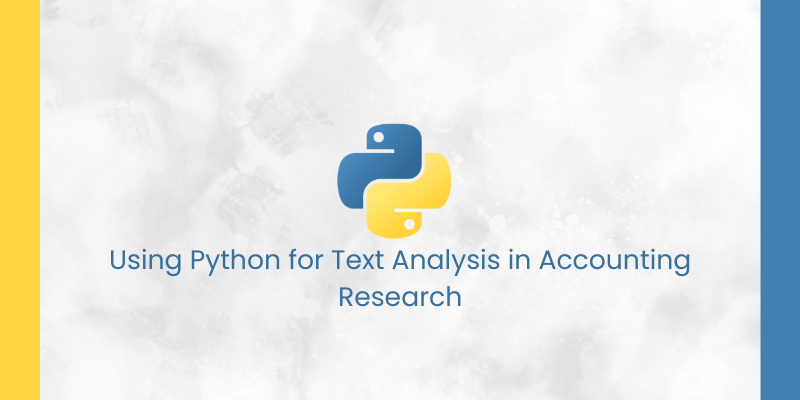Using Python for Text Analysis in Accounting Research

Introduction
In the ever-changing field of accounting research, the use of data to make decisions has become more significant. Traditional accounting practices depend heavily on numerically structured information; however, with the rise of big data, text-based data plays a significant role. Utilizing Python for analysis of text in accounting research allows researchers to gain valuable insight from their financial reports, earnings conference calls, regulatory filings, and many other sources of textual information. This article examines the ways Python can be used for text analysis in accounting research while following SEO best practices.
Importance of Text Analysis in Accounting Research
Research in accounting has traditionally focused on financial ratios, cash flow analysis, and auditing procedures. However, textual data in financial announcements, press releases, and analyst reports can provide useful information that can affect the decision-making process.
By implementing text analysis in accounting, researchers can:
- Detect fake financial statements.
- Examine the sentiment of earnings reports.
- Review risks within annual reports.
- Find patterns evident in financial disclosures.
With the growing accessibility of financial information in text, Natural Language Processing (NLP) within accounting practices is proving to be a crucial tool for both professionals and researchers.
Why Use Python for Text Analysis?
Python is now the most popular programming language for text analysis because of its:
- Numerous libraries: Python offers powerful NLP libraries, such as NLTK, spaCy, and TextBlob.
- User-friendliness: Python's simple syntax allows it to be used by beginners as well as experts.
- Scalability: Python can process large amounts of financial texts efficiently.
- Integration: Python easily integrates with machine learning models and data visualization tools.
Key Python Libraries for Text Analysis in Accounting
1. NLTK (Natural Language Toolkit)
NLTK is a popular library used for NLP tasks like stemming, tokenization, and sentiment analysis. It assists in extracting key information in financial reports.
import nltk
from nltk.tokenize import word_tokenize
text = "The company reported a 20% increase in revenue, signaling strong growth."
tokens = word_tokenize(text)
print(tokens)2. spaCy
spaCy is an extremely powerful NLP library designed for efficiency and speed, making it ideal for processing large accounting data.
import spacy
nlp = spacy.load("en_core_web_sm")
doc = nlp("The financial outlook of the company remains stable.")
for token in doc:
print(token.text, token.pos_)3. TextBlob
TextBlob simplifies NLP tasks like sentiment analysis and text classification.
from textblob import TextBlob
text = "The earnings report showed a significant loss."
analysis = TextBlob(text)
print(analysis.sentiment)Applications of Text Analysis in Accounting
1. Sentiment Analysis of Financial Reports
Sentiment analysis helps determine the mood of annual earnings reports, shareholder calls, or news stories. A positive tone indicates stability, while a negative tone could indicate potential risk.
text = "The company's revenue declined significantly."
analysis = TextBlob(text)
print(analysis.sentiment.polarity)2. Fraud Detection in Financial Statements
Text analysis can identify inconsistencies in financial reports. By comparing the language patterns of fraudulent and non-fraudulent financial reports, researchers can spot signs of fraud.
3. Risk Assessment in Regulatory Filings
Analyzing risk-related words in 10-K reports and audit disclosures can help determine a business’s financial health.
4. Trend Identification in Market Reports
Python can process huge volumes of financial documents to identify emerging trends, such as industry shifts or regulatory changes.
Conclusion
Utilizing Python training course for text analysis in accounting research has revolutionized the way financial data is evaluated. With the help of powerful NLP tools such as NLTK, spaCy, and TextBlob, researchers can uncover valuable insights, detect financial fraud, assess risks, and identify patterns in financial reports. As technology advances, NLP in accounting continues to play a crucial role in financial decision-making.
Through text analysis in accounting, professionals can improve research efficiency, enhance financial forecasts, and gain a competitive edge. Whether you're an accounting researcher, financial analyst, or data scientist, Python provides the tools needed to unlock the potential of financial text.